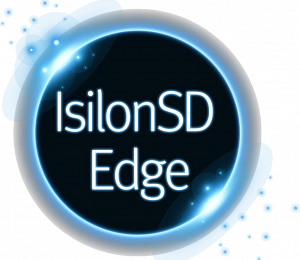Introducing EMC’s Data Lake 2.0! Building upon the Data Lake announced earlier this year, EMC has debuted three new Isilon software products—IsilonSD Edge, CloudPools and the next generation of Isilon’s OneFS operating system—to expand the Data Lake by connecting unstructured data at the core, in the cloud and at the edge.
These new products are driven by the continued, explosive growth of unstructured data, especially as wearables become more refined and mainstream and the number of devices per user continues to grow. According to Gartner, by 2020, the world will have 30 billion connected devices—a 6x increase over where we are today—and all of those devices will be churning out data at a rapid pace.
WHAT IS AN EXPANDED DATA LAKE?
Unlike early Data Lake iterations, which focused on optimizing for multiple workloads in a single data center experience, Data Lake 2.0 is a global entity and connects edge locations beyond a single data center, including the cloud. EMC is enabling Data Lake 2.0 through three new offerings:
- EMC IsilonSD Edge, a Software-Defined Storage, file-based solution customers can deploy on commodity hardware to extend the edge of the Data Lake in 36TB increments.
- Next-generation of OneFS, the next release of Isilon’s renowned OneFS operating system provides enterprise-grade continuous service for the data center by expanding non-disruptive upgrade and rollback capabilities.
- EMC CloudPools extends the Data Lake to the cloud, providing new efficiency gains by embracing the cloud as an archiving storage tier for cold data, while still making it accessible for on-demand analytics.
EDGE CHALLENGES?
According to ESG, 53% of enterprises today have over 100 branch locations (as compared to 30% in 2011), and expanding the Data Lake to the edge increases data access and productivity for knowledge workers. In today’s world of infinite data, organizations must adapt and shift access closer to users for increased productivity.
 EMC IsilonSD Edge Software-Defined Storage expands the Data Lake with following benefits:
EMC IsilonSD Edge Software-Defined Storage expands the Data Lake with following benefits:
- LARGE CAPACITY: Up to 36TB per edge location ensures that branch offices have the storage capacity they need to be productive.
- PROTOCOL AND DATA SERVICES CONSISTENCY: Data access flexibility is unmatched, with multi-protocol support for HTTP, SWIFT, HDFS, SMB and NFS.
- ECONOMICS: IsilonSD Edge is 100% software, running in VMware on COTS hardware and providing organizations with cost advantages and a range of deployment options.
The edge is just one focus of this trio of enabling technologies. Next up: The core and the cloud. The next generation of OneFS and new CloudPools enhance the Data Lake by providing:
- SEAMLESS EXPANSION: CloudPools helps extend the Data Lake to the cloud by enabling a “frozen data” storage tier. The best part is that no cloud gateway is required and both users and applications retain full visibility and access to this data whenever they wish.
- CLOUD-SCALE CAPACITY: Expand beyond the current 50PB scale of a single Isilon Cluster today to Cloud-Scale removing barriers and storage limitations.
- CLOUD SECURITY: Keeps data secure in the cloud. All CloudPools data is sharded, compressed and encrypted for maximum protection.
- CONTINOUS OPERATIONS: Rely on the core data center and eliminate disruption to users and applications. The next generation of OneFS introduces upgrade and rollback options that increase data availability.

- MAXIMUM FLEXIBILITY: Choose the right cloud for the business, with a flexible choice of public cloud providers, including Virtustream, Amazon Web Services, and Microsoft Azure. Private cloud choices include EMC Elastic Cloud Storage ECS and Isilon.
- ECONOMIC CHOICE: Expand storage with CAPEX or adopt public cloud storage to shift to an OPEX-based cost model while gaining nearly
unlimited storage capacity.
We support all major HDFS providers: Pivotal, Cloudera, Hortonworks, and IBM
Products and pricing available in early 2016.
Disclosure Regarding Forward Looking Statements
This communication contains forward-looking information about EMC Corporation and the proposed transaction that is intended to be covered by the safe harbor for “forward-looking statements” provided by the Private Securities Litigation Reform Act of 1995. Actual results could differ materially from those projected in the forward-looking statements as a result of certain risk factors, including but not limited to: (i) the failure to obtain the approval of EMC shareholders in connection with the proposed transaction; (ii) the failure to consummate or delay in consummating the proposed transaction for other reasons; (iii) the risk that a condition to closing of the proposed transaction may not be satisfied or that required financing for the proposed transaction may not be available or may be delayed; (iv) the risk that a regulatory approval that may be required for the proposed transaction is delayed, is not obtained, or is obtained subject to conditions that are not anticipated; (v) risk as to the trading price of Class V Common Stock to be issued by Denali Holding Inc. in the proposed transaction relative to the trading price of shares of VMware, Inc.’s common stock; (vi) the effect of the proposed transaction on VMware’s business and operating results and impact on the trading price of shares of Class V Common Stock of Denali Holding Inc. and shares of VMware common stock; (vii) the diversion of management time on transaction-related issues; (viii) adverse changes in general economic or market conditions; (ix) delays or reductions in information technology spending; (x) the relative and varying rates of product price and component cost declines and the volume and mixture of product and services revenues; (xi) competitive factors, including but not limited to pricing pressures and new product introductions; (xii) component and product quality and availability; (xiii) fluctuations in VMware’s operating results and risks associated with trading of VMware common stock; (xiv) the transition to new products, the uncertainty of customer acceptance of new product offerings and rapid technological and market change; (xv) the ability to attract and retain highly qualified employees; (xvi) insufficient, excess or obsolete inventory; (xvii) fluctuating currency exchange rates; (xiii) threats and other disruptions to our secure data centers or networks; (xix) our ability to protect our proprietary technology; (xx) war or acts of terrorism; and (xxi) other one-time events and other important factors disclosed previously and from time to time in EMC’s filings with the U.S. Securities and Exchange Commission (the “SEC”). Except to the extent otherwise required by federal securities laws, EMC disclaims any obligation to update any such forward-looking statements after the date of this communication.